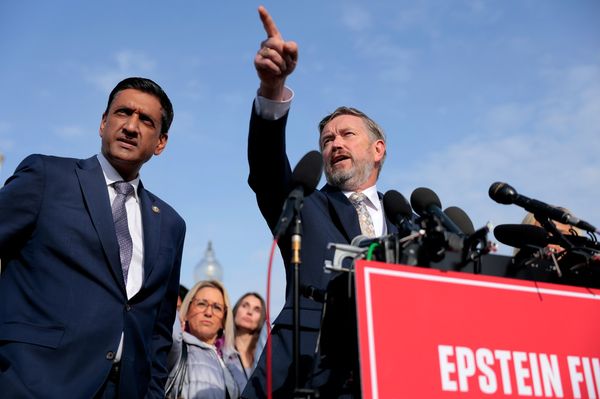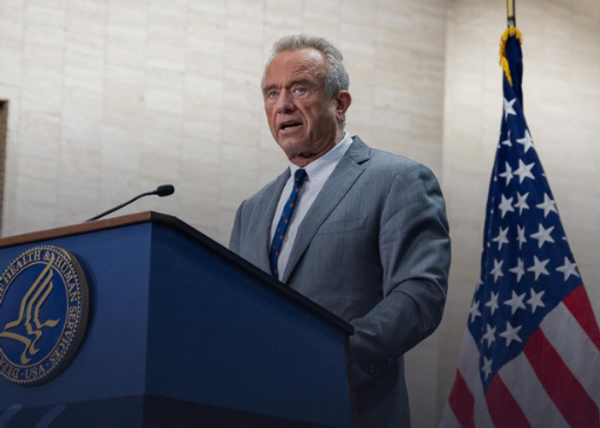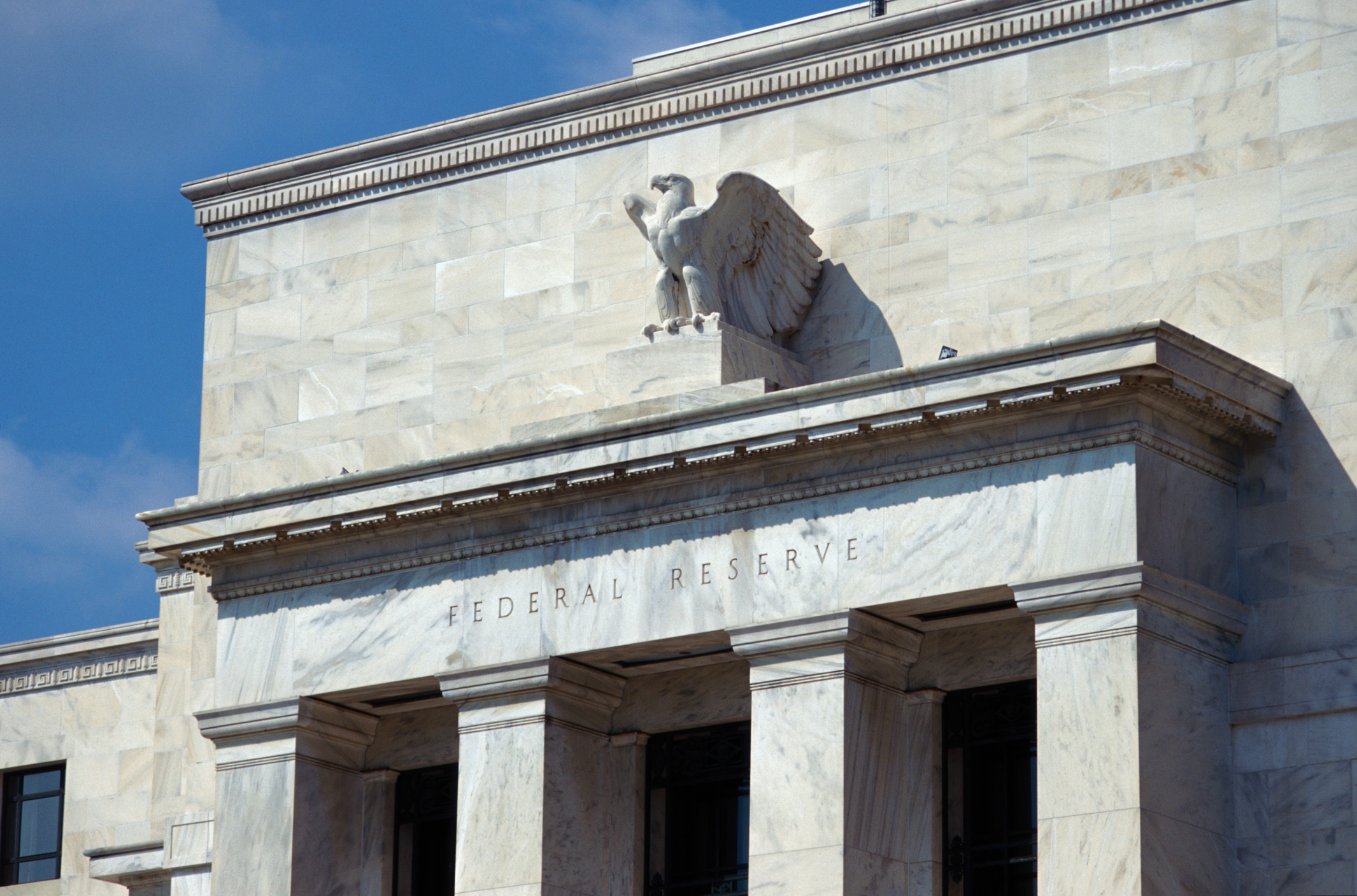
The June Fed meeting concluded on Wednesday, June 18, with the central bank's latest policy decision.
As expected, the Federal Open Market Committee (FOMC) did not cut interest rates this time around, but the central bank's Summary of Economic Projections (SEP), or "dot plot," shows the central bank expects two quarter-point percentage cuts to the federal funds rate by year's end.
Wall Street also looked to Federal Reserve Chief Jerome Powell's press conference to see how President Donald Trump's tariff policies could impact the central bank's decisions moving forward, though the chair maintained his data-dependent mantra.
The Kiplinger team reported live on the June Fed meeting, bringing you the news and our expert analysis of what it could mean for the economy. Join us again in July for the next Fed meeting.
What Is the Federal Funds Rate? | Master the Fed Funds Rate, Help Clients Master Retirement | Why Does the Fed Prefer PCE Over CPI?
President Trump's tariff policies have yet to impact inflation
Inflation eased more than expected in May, according to the Bureau of Labor Statistics.
Headline CPI was up 0.1% month over month in May, slower than April's 0.2% rise and the 0.2% increase economists expected.
The CPI was 2.4% higher year over year, slightly higher than the 2.3% increase seen the month prior and in line with economists' projections.
Shelter was the "primary factor" for the increase in headline CPI, according to BLS, up 0.3% on the month. Energy costs, meanwhile, were down 1% in May as gas prices declined.
Core CPI, which excludes volatile food and energy prices and is seen as a better measure of underlying inflation trends, was up 0.1% from April to May and 2.8% year over year. Economists expected 0.3% and 2.9% increases, respectively.
The May CPI report, alongside news that the U.S. and China have reached a trade deal, is doing little to move the needle on rate-cut expectations.
According to CME FedWatch, futures traders are pricing in a 99.9% chance the central bank will hold rates steady, with the first quarter-point rate cut not expected until September.
- Karee Venema
The labor market remains resilient
The Federal Reserve has a dual mandate of price stability and maximum employment – and both sides appear to be on solid footing at the moment.
Indeed, while the May Consumer Price Index signaled progress on the inflation front, the most recent jobs report showed a resilient labor market.
According to the Labor Department, the U.S. added 139,000 new jobs last month, more than economists expected. And while figures for March and April were revised down, the unemployment rate remained at a historically low 4.2%.
"It's clear that the economy remains resilient, with the job market holding up well," said Chris Zaccarelli, chief investment officer at Northlight Asset Management.
The CIO added that the Fed "should be reluctant to cut rates because the full effects of tariffs haven't impacted inflation numbers yet and the job market isn't deteriorating enough to force their hand."
- Karee Venema
When is Jerome Powell's term as Fed chair up?
Despite President Trump's innuendos that he would like to fire Fed Chair Jerome Powell, the Supreme Court has suggested that it would oppose such an action.
Indeed, Trump in April used his Truth Social platform to call for Powell's termination, while an April 17 report in The Wall Street Journal discussed private meetings where the president expressed his desire to remove the Fed chair from his post.
Nevertheless, the question of whether or not Trump can fire Powell is seemingly moot given that his term as Fed chair is up in less than a year from now – on May 15, 2026.
It's unlikely that those in Trump's inner circle will encourage him to disrupt the status quo – and likely send stocks and bonds tumbling – when Powell has such a small amount of time left in his term.
For what it's worth, Powell's term as a member of the Board of Governors of the Federal Reserve ends on January 31, 2028.
- Karee Venema
How long will we have to wait for a Fed rate cut?
The Federal Reserve is not going to change rates at its June 17-18 meeting next week. In fact, don't expect the central bank to make any adjustments until maybe its October meeting.
The Fed wants to know how tariffs are affecting both inflation and the economy. Until the impact is clearer, the Fed will wait.
Yes, that raises the risk that the Fed will act too late, but it may be better to wait at the crosswalk than to look the wrong way crossing the street.
- David Payne
Who gets to vote on Fed policy?
The Federal Open Market Committee (FOMC), which is the Federal Reserve's policy-setting group, has 12 members, eight permanent and four who rotate each year.
The eight permanent voting committee members include the Fed chair and vice chair, the five Fed governors and the president of the New York Fed.
Four regional Fed presidents are rotated in each calendar year.
The 2025 FOMC voting committee consists of:
- Fed Chair Jerome Powell
- Vice Chair Philip Jefferson
- Fed Governor Michael Barr
- Fed Governor Michelle Bowman
- Fed Governor Lisa Cook
- Fed Governor Adriana Kugler
- Fed Governor Christopher Waller
- New York Fed President John Williams
- Boston Fed President Susan Collins
- Chicago Fed President Austan Goolsbee
- St. Louis Fed President Alberto Musalem
- Kansas City Fed President Jeffrey Schmid
In 2026, the presidents from Cleveland, Philadelphia, Dallas and Minneapolis will rotate in as FOMC voting members, according to the Federal Reserve.
- Karee Venema
Wholesale prices rose less than expected in May
Wall Street continues to be met with encouraging inflation data, indicating that President Trump's aggressive tariff policies have yet to impact price growth.
Ahead of Thursday's open, data from the Bureau of Labor Statistics showed that the Producer Price Index (PPI), which measures what businesses are paying suppliers for goods, was up 0.1% month over month in May.
While this was quicker than the revised 0.2% decline seen in April, it was slower than the 0.2% rise economists expected.
Year over year, wholesale prices rose 2.6%, in line with expectations.
Core PPI, which excludes volatile food and energy costs, was up 0.1% on a monthly basis and 3.0% higher year over year.
Economists had called for core PPI to increase 0.3% and 3.1% monthly and yearly, respectively.
These soft back-to-back readings on inflation give "the Fed room to sit on their hands," says Chris Zaccarelli, chief investment officer for Northlight Asset Management.
"As long as inflation isn’t increasing – or even better, is decreasing – the Fed can be patient and wait for more information on how the new tariffs and trade negotiations are going to impact the price stability part of their dual mandate later this year," he adds.
- Karee Venema
What is the FOMC meeting schedule?
The Federal Open Market Committee meets eight times a year, or about once every six weeks. The FOMC is required to meet at least four times a year and may convene additional meetings if necessary.
The convention of meeting eight times per year dates back to the market stresses of 1981.
FOMC meetings last two days and conclude with the committee releasing its policy decision at 2 pm Eastern time. The Fed chair then holds a press conference at 2:30 pm.
Pro tip: As closely scrutinized as the FOMC statement might be, market participants are usually even more keen on what the Federal Reserve chair has to say in the press conference.
Read more: When Is the Next Fed Meeting?
Jobless claims hold steady
The Labor Department said Thursday that initial jobless claims held steady at 248,000 in the week ending June 7, higher than the 242,000 economists expected.
The four-week moving average rose by 5,000 to 240,250. "This is the highest level for this average since August 26, 2023 when it was 245,000," according to the Labor Department.
Bill Adams, chief economist at Comerica, says that while this report shows the labor market is softening, the data are not so clear-cut.
"While the Department of Labor tries to adjust the claims data for seasonal variations, that’s easier said than done," Adams notes. "Initial and continued claims are up from the spring, but both rose from spring to summer in 2023 and 2024 as well."
The difference between now and then, the economist explains, is that in 2025, folks who have lost their jobs are having a harder time finding a new one.
- Karee Venema
A "shadow" Fed chair?
Bloomberg reports President Donald Trump is considering Treasury Secretary Scott Bessent – amid his tariffs-and-trade war star ascension – to be the next Federal Reserve chair.
Jerome Powell, the current Fed chair, presumably will be in charge of things at 20th Street and Constitution Avenue in Washington, D.C., through May 15, 2026.
And yet the primary occupant at 1600 Pennsylvania Avenue continues to do his very best to get Powell to cut interest rates.
Markets have been wary of President Trump's attempts to compromise the independence of the central bank for evermore.
And Bessent, before he was even a nominee for a cabinet position, detailed for Barron's a plan to work around Powell.
"You could do the earliest Fed nomination and create a shadow Fed chair," Bessent said in an interview published October 9. "And based on the concept of forward guidance, no one is really going to care what Jerome Powell has to say anymore."
Perhaps Bessent is the change Trump has been waiting for…
- David Dittman
Trump, Vance pile up on Powell
President Trump turned his ire toward Jerome Powell again on Thursday, calling the Fed chair a "numbskull" for not cutting interest rates.
The president said the U.S. could save $600 billion a year if the FOMC lowered the federal funds rate by 2 percentage points, but they "can't get this guy to do it."
Trump added that he "may have to force something" if inflation keeps falling and the Fed remains on the sidelines.
This follows Wednesday's comments from Vice President J.D. Vance, who wrote in a post on X that "the refusal by the Fed to cut rates is monetary malpractice."
Throughout his tenure, Powell has been adamant about the Fed's independence and told President Trump when they met in May that the central bank would make monetary policy decisions "based solely on careful, objective and non-political analysis."
- Karee Venema
S&P 500 nears record high ahead of the Fed meeting
Stocks closed higher Thursday, bringing the S&P 500 closer to record-high territory. The broad-market index settled at 6,045.26 on June 12, putting it less than 2 percentage points away from surpassing its all-time closing high of 6,144.15 from February 19.
The fact that we're even talking about record highs for the stock market is fairly remarkable considering stocks were flirting with a new bear market back in April after President Trump's aggressive retaliatory tariffs sparked a major sell-off.
Since April 8, the S&P 500 is up more than 21% and is now nearly 3% higher for the year to date.
"The return of cyclical leadership and broad participation since the April 8 low provides additional technical evidence of a sustainable recovery," says Adam Turnquist, chief technical strategist for LPL Financial.
Turnquist says "bullish but not overbought momentum, relatively light investor positioning, and sanguine but not stretched investor sentiment" suggests that this rally has legs.
- Karee Venema
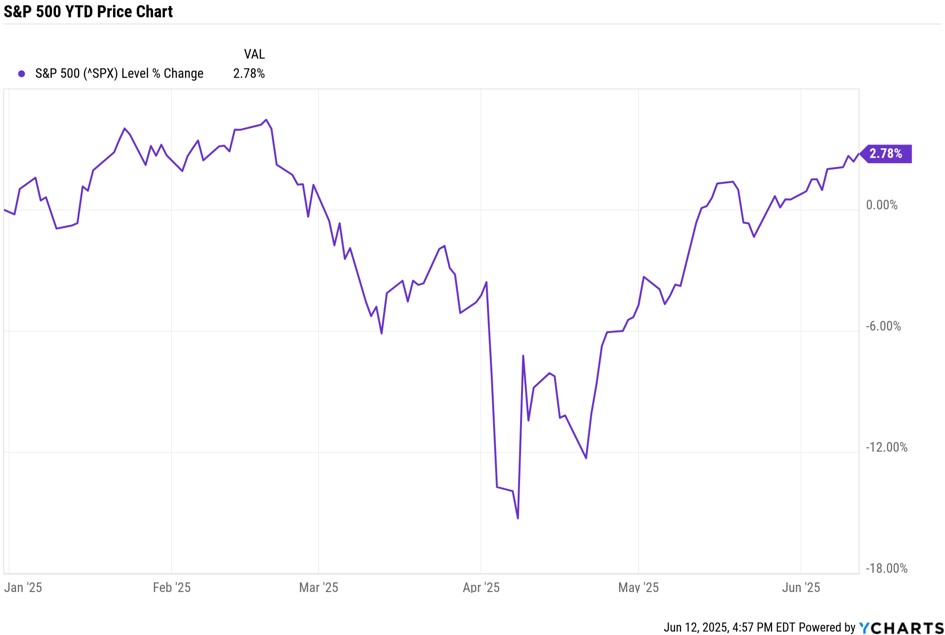
Stock futures drop after Israel attacks Iran
Global equity markets are falling Friday after Israel launched airstrikes on Iran overnight, killing the head of the Islamic Revolutionary Guard Corps and hitting several nuclear facilities.
The strikes will continue "for as many days as it takes," said Israeli Prime Minister Benjamin Netanyahu, in order to "roll back [Iran's] uranium threat."
President Trump warned that these additional strikes "could be more brutal," and encouraged Iran to make a deal with Israel "before there is nothing left."
But Ayatollah Ali Khamenei, Iran's supreme leader, said that Israel "should anticipate a harsh punishment."
At last check, futures on the Dow, S&P 500 and Nasdaq were all down roughly 1%. Oil futures, meanwhile, were 8% higher at last check to trade near their highest level since early 2025.
While Israel's attack on Iran is unlikely to alter the Fed's decision next week, the central bank will certainly be watching the jump in oil prices and its impact on inflation.
- Karee Venema
Tariffs could lift inflation to 3%, Yellen says
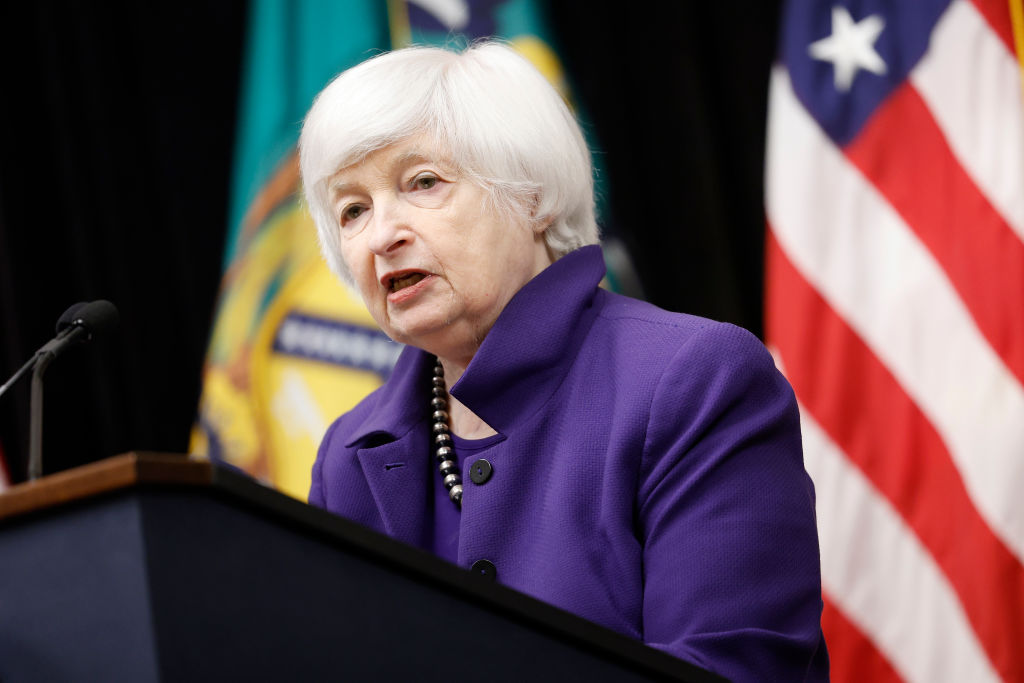
Former Treasury Secretary Janet Yellen talked tariffs in an appearance on CNBC's "Money Movers."
Yellen, who preceded Jerome Powell as Fed chair, said that she expects the annual inflation rate to be "at least 3%" at the end of this year, "because of the tariffs."
For reference, the annual inflation rate for 2024, as measured by the Consumer Price Index, was 2.9%.
She also said the "most recent and optimistic outlook" that she's seen suggested the average household will incur a $1,000 hit to income as a direct result of tariffs, as well as their broader impact.
However, Yellen acknowledged that "there remains a huge degree of uncertainty" around the Trump administration's trade policies, which, she said, will keep Powell & Co. "firmly in latency territory."
- Karee Venema
Let's talk about the Fed and sentiment surveys
The Fed will certainly take notice of the surge in consumer sentiment reflected in preliminary University of Michigan survey data for June. Improvement at the headline level for the first time in six months is good news.
Details are good too.
"All five index components rose," writes survey director Joanne Hsu, "with a particularly steep increase for short and long-run expected business conditions, consistent with a perceived easing of pressures from tariffs."
Meanwhile, Hsu continues, "Consumers appear to have settled somewhat from the shock of the extremely high tariffs announced in April and the policy volatility seen in the weeks that followed."
Indeed, one-year-ahead inflation expectations plunged from 6.6% to 5.1%, and the five-year figure ticked down from 4.2% to 4.1%, both readings the lowest in three months.
OK, here's the thing… The Fed already had a read on improved sentiment – including all-important inflation expectations – based on a dataset it probably favors.
The Michigan survey is robust and trustworthy, no question. However, the New York Fed Survey of Consumer Expectations includes design features that set its data apart on a head-to-head basis.
The New York Fed simply asks more people more specific inflation-related questions, and it asks basically the same group of people questions designed to reflect current conditions over the course of 12 months.
Both surveys use "rotating" panels. But Michigan polls a new set of respondents every month, which its designers say smooths potential biases and captures a broader range of opinion.
The NY Fed tracks a fixed group of respondents over the course of a year, with a consistent fraction of respondents entering and exiting the panel each month.
So monetary policymakers are able to track changes over time at a more granular level.
Michigan is useful. We also cross-check that kind of soft data with actual behavior in the form of hard retail sales data, for example, for a broader look at consumer health.
The New York Fed, by comparison, is a harder form of soft data, specifically with regard to inflation expectations.
- David Dittman
Retail sales arrive ahead of the Fed meeting
Retail sales are one of the more noteworthy events on next week's economic calendar. The data gives a key look at inflation and consumers' ability and willingness to spend money.
In April, retail sales rose a stronger-than-expected 0.1%, while March's increase was upwardly revised to 1.7%.
"The lack of a pullback in April sales indicates that consumers are still buying heavily in anticipation of price increases driven by new tariffs later," writes David Payne, staff economist at The Kiplinger Letter, in Kiplinger's retail outlook.
For May, BofA Securities economists Aditya Bhave and Shruti Mishra expect retail sales growth to be flat month to month as positive seasonal factors will offset weak spending on home improvement, groceries, gas and furniture.
Retail sales will be released on Tuesday, June 17, at 8:30 am Eastern Standard Time.
- Karee Venema
What will the dot plot reveal?
It's all but certain that the Fed will keep interest rates unchanged this time around, but there is still plenty that could move markets.
Indeed, this meeting will include the release of the central bank's Summary of Economic Projections (SEP), or "dot plot," which summarizes what each member expects monetary policy to be going forward.
In March, the Fed's dot plot indicated expectations that the federal funds rate would be lowered to 3.9% by the end of 2025, suggesting just two quarter-point rate cuts by year's end.
The March SEP also implied expectations for slower growth, higher unemployment and a slight increase in inflation.
A team of Deutsche Bank economists led by Matthew Luzzetti expects the dot plot will show expectations for just one rate cut this year and for a downgrade to GDP growth for 2025 (to 1.3% from 1.7%).
They believe the unemployment rate projection will remain unchanged at 4.4%, while the year-end inflation forecast, which "will be the most difficult to assess given the uncertainties around tariffs," will rise to 3.0% from 2.8%.
- Karee Venema
Why it's a safe bet that Powell will wear a purple tie on Wednesday
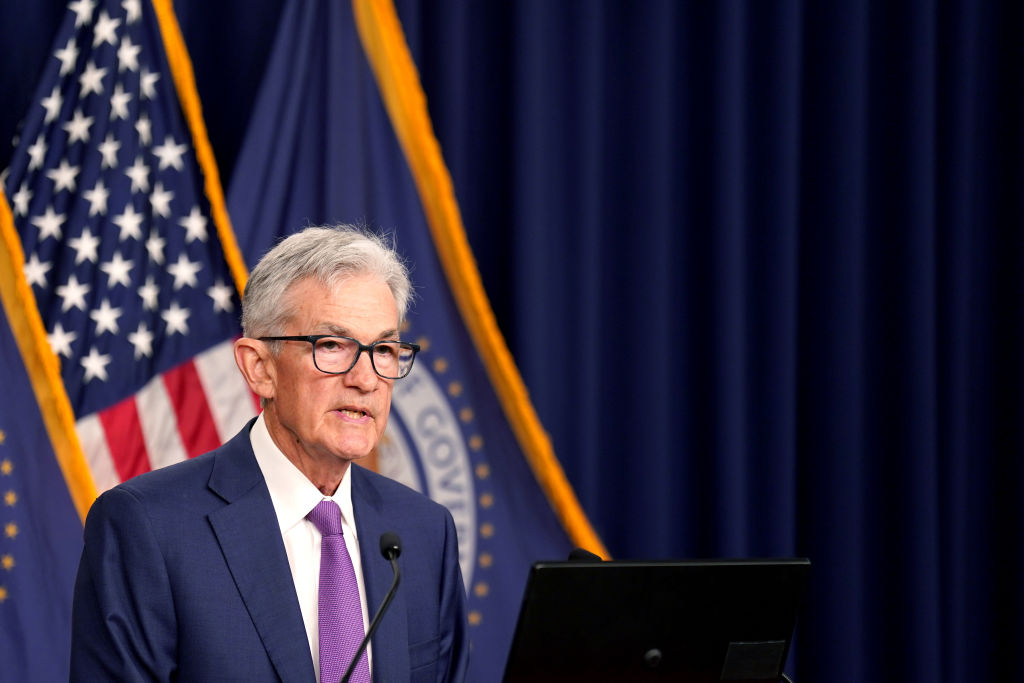
While the odds of a June rate cut are low, the odds are high that Federal Reserve Chair Jerome Powell will wear a purple tie during Wednesday's press conference.
That's because Powell always wears a purple tie. And there's a reason for it.
During an early April Q&A session with journalists at the Society for Advancing Business Editing and Writing (SABEW) conference, Powell was asked about the significance of his purple ties.
"At the beginning, the only significance was that I like purple ties," Powell replied. At his next press conference, he said he went to reach for a red or blue tie and thought, "Maybe not … so I wind up wearing purple."
He said now it's become "a thing," and it supports the fact that the Fed "is strictly non-political" and "bipartisan," and purple is a good color for that.
"Plus, I like purple ties," Powell concluded.
- Karee Venema
What time will the Fed statement be released?
The Federal Open Market Committee will release its updated policy statement at 2 pm Eastern Standard Time on Wednesday, June 18.
"Uncertainty about the economic outlook has increased further," the FOMC noted in its May policy statement, adding that the committee "is attentive to the risks to both sides of its dual mandate and judges that the risks of higher unemployment and higher inflation have risen."
This time around, Deutsche Bank economists expect some minor adjustments to the statement, including the removal of a reference to net exports weighing on first-quarter gross domestic product, which caused a contraction in U.S. economic activity.
The economists note that most data points released since Q1 GDP point to solid economic activity and labor market conditions.
- Karee Venema
Stocks eye a higher open to start Fed week
Futures on the major U.S. stock indexes are pointed higher Monday morning as investors shrug off escalating tensions between Israel and Iran.
At last check, futures on the blue chip Dow were up 0.6%, while the broader S&P 500 was 0.7% higher and the tech-heavy Nasdaq had gained 0.8%.
Elsewhere, crude oil looks set to give back some of last week's big gains, with the front-month contract trading down 2%, while gold futures are off 0.6%.
- Karee Venema
What are Fed officials saying about rate cuts?
Federal Reserve officials have had plenty to say about interest rates since the policymakers last met in May – with many repeating Fed Chair Powell's "wait-and-see" mantra.
"Since the FOMC's May meeting, several FOMC participants reiterated that the Committee is well positioned to wait for greater clarity before considering any adjustments to the stance of monetary policy," Goldman Sachs explains.
Goldman Sachs adds that members continue "to suggest that the bar for cutting is currently high" amid elevated uncertainty and sticky inflation.
Indeed, in prepared remarks for a June 5 appearance at a banking policy event, Kansas City Fed President Jeffrey Schmid said, "While theory might suggest that monetary policy should look through a one-time increase in prices, I would be uncomfortable staking the Fed's reputation and credibility on theory."
Schmid went on to say that although long-term inflation expectations remain anchored, "this is not a signal that we should let our guard down."
Meanwhile, at a June 5 event at the Economic Club of New York, Fed Governor Adriana Kugler noted that monetary policy, which she views as "modestly restrictive," is "currently appropriate to achieve and sustain 2 percent inflation over the longer term."
Kugler adds that she supports maintaining interest rates at current levels "if upside risks to inflation remain."
- Karee Venema
Does the Fed respond to oil price shocks?
As of Monday afternoon, CME Group's FedWatch is pricing a 99.9% probability the Federal Reserve holds the target range for the federal funds rate at 4.25% to 4.50%.
The probability the Fed holds again in July has ticked up to 85.5% from 76.9% on Friday. Traders have pared bets on a September cut, too.
So the market is "pricing out" interest-rate cuts despite the outbreak of hostilities between Israel and Iran.
It's unlikely the Fed would intervene preemptively to mitigate the potential impact of a regional war on financial markets.
The variable to watch when it comes to the central bank and the Middle East is crude oil.
There's a paper on the very topic – Does the Fed Respond to Oil Price Shocks? – and the answer is, in short, "not exactly."
In their October 2009 paper, Lutz Kilian and Logan Lewis of the University of Michigan "show that there is no evidence of systematic monetary policy responses to oil price shocks after 1987."
An escalation of hostilities that constrains supply over a meaningful time frame and causes a sustained price spike could spark inflation. So the Fed would likely hold off on trimming the target range for the federal funds rate.
That's what fed funds futures traders are factoring right now.
- David Dittman
Fed Week is a short one for investors
Market participants will have one fewer day to react to the Federal Reserve's latest policy statement and Fed Chair Powell's press conference than usual.
That's because the stock and bond markets will be closed this Thursday, June 19, in observance of the Juneteenth holiday.
In 2021, Juneteenth, which commemorates the end of slavery, became the 11th federal holiday and the first new federal holiday since Martin Luther King, Jr. Day was signed into law in 1983.
You can see the full list of stock and bond holidays in 2025 here.
More on what Fed officials are saying
Public appearances by voting members of the FOMC in recent weeks have "been informative" ahead of Wednesday's policy decision, says Brian Mulberry, client portfolio manager at Zacks Investment Management.
While most of the commentary has aligned with the central bank "taking a slow and measured approach" to policy changes, there's some divergence on how central bankers are "weighing each side of the [Fed's] dual mandate," Mulberry notes.
The portfolio manager explains that some members are "concerned about rising price pressures from tariffs," while others are worried that slowing growth will cause unemployment to rise.
The problem for both sides, he believes, "is that the current data do not support the theory that prices are rising or that the labor market is weakening quickly."
This strengthens the case for a Fed pause this week, Mulberry says, and "makes any comments or statements from the FOMC or Powell in his Q&A more impactful for markets."
Mulberry adds that he'll be looking for any potential dissent among FOMC voting members, as well as commentary on how Fed officials view the strength of the economy and its ability to withstand restrictive policy levels.
"Given the 'wait and see' majority mentality, it is hard to expect more than one or two rate cuts in 2025, and it is most likely to be in the September and December meetings," he says.
- Karee Venema
Powell replacement chatter picks up
Jerome Powell's term as Fed chief will end in May of next year, but with President Donald Trump vocally expressing his frustration with the chair, many folks are speculating that it could end sooner.
As such, there's been plenty of chatter building as to who will replace Powell as head of the Federal Reserve.
As we previously mentioned, current Treasury Secretary Scott Bessent's name has recently been thrown around due in part to his prior comments about a "shadow Fed chair."
Other names in the running include Fed Governor Christopher Waller and former Fed Governor Kevin Warsh.
Read more: Who Will Replace Jerome Powell as Fed Chair?
Retail sales fall more than expected in May
Retail sales fell 0.9% from April to May, steeper than the 0.6% drop economists expected. A scaling back of car sales weighed on the data. Excluding motor vehicles, retail sales were down 0.3%. Year over year, retail sales were up 3.3%.
According to the Census Bureau, April retail sales were downwardly revised from a 0.1% gain to a 0.1% decline.
"Like the economy as a whole, consumer spending has been resilient in the face of tariff uncertainty," says Ellen Zentner, chief economic strategist for Morgan Stanley Wealth Management. "Today's data suggests consumers are downshifting, but they haven't yet slammed the brakes."
- Karee Venema
When will Fed Chair Powell speak?
Federal Reserve Chair Jerome Powell's press conference is scheduled to begin at 2:30 pm Eastern Standard on Wednesday, June 18.
"Chair Powell seems likely to highlight the uncertainty, and lean on that when asked tough questions," says UBS Global Research economist Jonathan Pingle. "He did a lot of that in the May press conference too."
Pingle adds that Powell may caution that the June dot plot could be stale in just a few weeks' time, given that "conditions and assumptions for the projections could change quickly and dramatically."
But the economist believes the Fed chair will note that longer-term expectations are well-anchored and he will "likely stress their importance, plus the reliance of broader economic health on price stability."
- Karee Venema
Bank of Japan's bond purchase plan; Bank of England meets Thursday
This week is a busy one for global central banks. On Tuesday, the Bank of Japan concluded its policy meeting, keeping its key interest rate at 0.5%.
The BoJ also said it will continue to slow bond purchases by 400 billion yen each quarter through March of next year. It will then cut bond purchases to 200 billion yen per quarter from April 2026 through March 2027.
The Bank of England is also meeting this week, with the central bank set to release its latest statement on Thursday, June 19.
"We expect the Bank of England to keep rates on hold with a 7-2 vote," write BofA Securities' Global Rates & Currencies Research team.
This follows a higher-than-expected April inflation reading, which hit its highest level in 15 months. May inflation data for the U.K. will be released tomorrow, June 18.
"Guidance since the May meeting suggests the MPC is unlikely to steer out of cycle in the easing cycle and recent developments in the Middle East perhaps reinforce that position," the group adds.
However, the group anticipates rate cuts from the BoE in August, September and November.
- Karee Venema
Industrial production downshifted in May
The Federal Reserve said Tuesday that industrial production fell 0.2% in May, a notable reversal from April's 0.1% increase.
Still, manufacturing activity was up 0.1% thanks to solid demand for motor vehicles and parts.
The report also showed that capacity utilization, which measures how much of the potential output is being used, edged down to 77.4% from 77.7%.
"May’s decline in industrial production wasn’t as bad as the headline since it was mostly driven by utilities output, which is influenced more by the weather than by the business cycle," says Bill Adams, chief economist at Comerica.
He adds that the increase in manufacturing of motor vehicles and parts came after consumers rushed to buy new cars in March and April, which depleted inventories on dealer lots.
Adams doesn't expect this trend to continue, though, considering sales of new cars and light trucks fell in May.
"In short, the latest monthly economic indicators confirm that the economy operated in low gear in May," the economist says.
- Karee Venema
Who appointed Jerome Powell as Fed chair?
Jerome Powell stepped into his role as Fed chair on February 5, 2018, after being nominated by then-President Donald Trump, who was serving his first term in the White House.
Powell's initial four-year stint as head of the Federal Reserve ended in 2022, but he was reappointed for a second four-year term on May 23, 2022, after being nominated by then-President Joe Biden.
Powell initially joined the Fed's Board of Governors in 2012 after he was nominated by then-President Barack Obama.
While Powell's second term as Fed chair will expire in May 2026, he will remain on the Fed's board until January 2028.
- Karee Venema
Just like us
So I've got this weird affinity for Fed Chair Jerome Powell simply because we both went to law school but found our way, through wildly divergent paths, into finance.
We have a Juris Doctor in common, though I'm certainly no J-Powell. I do, however, appreciate his commitment to fact-gathering and recognize it as a vestige of our shared professional schooling.
At the same time, when I read Nick Timiraos this morning, I see the Fed chair confronting the same kind of uncertainty about the potential impact of tariffs that all consumers – JD or no – confront.
"Officials are worried over how tariff announcements since March could disrupt what economists refer to as 'inflation expectations'," The Wall Street Journal reporter, widely known for his contacts inside the Eccles Building, writes.
"Inflation expectations," Timiraos explains, are "what consumers and businesses think inflation will be in the future" and "can’t be seen or touched."
As we discussed in an earlier post, the University of Michigan and the New York Fed conduct surveys on consumer sentiment, including inflation expectations, as does The Conference Board. Observers also watch futures markets and traders' positions on the trajectory of inflation.
As Timiraos notes, expectations are "very tricky to measure" and at the same time "very important" to policymakers: A lot of academic study indicates expectations "play a crucial role in determining actual inflation."
That's because consumers "pull forward" purchases if they think prices will rise. Workers will ask for raises in anticipation of rising living expenses.
Producers and retailers will behave in similar ways: buying today because costs will be higher tomorrow, and raising prices too.
It's a cycle. And it seems like, even if we don't have as much insight into its dynamics as the professionals, we're all in the same drifting boat.
- David Dittman
Should you open a CD ahead of the Fed announcement?
Demand for certificates of deposit (CDs) has been on the rise in recent years, thanks to elevated interest rates, which weighed on stock market returns and had investors seeking out less-risky options.
With the Fed unlikely to start cutting interest rates until September, now could be an ideal time to lock in attractive yields on CDs.
The difference in yields on short-term and long-term CDs is minimal at the moment, so if you do decide to open a certificate of deposit, your choice between the two could rest with how long you're able to lock up your cash.
Remember that when putting your money into certificates of deposit, you're unable to access it until the CD matures. If you do withdraw funds ahead of time, you'll be charged a fee.
Read more: Should You Get a Long-Term or Short-Term CD Before the Next Fed Meeting?
Stock futures rise on Fed Day
Stock futures are pointed cautiously higher on Fed Day as investors look ahead to this afternoon's 2 pm EST policy statement and updated SEP from the FOMC. Fed Chair Powell will begin his press conference at 2:30 pm EST.
At last check, futures on the Dow were up 0.03%, while the S&P 500 was signaling a 0.7% gain and the Nasdaq was 0.2% higher.
Trump chimes on on Powell ahead of Fed announcement
Speaking to reporters outside the White House this morning, President Donald Trump issued his latest attacks on Fed Chair Powell.
"So we have a stupid person. Frankly, you probably won't cut today,” Trump told reporters, according to CNBC. "Europe had 10 cuts, and we had none. And I guess he's a political guy, I don't know. He's a political guy who's not a smart person, but he's costing the country a fortune."
For what it's worth, the European Central Bank has lowered its benchmark rate eight times in the past year. The Fed has issued three rate cuts.
- Karee Venema
Jobless claims edge lower
The Labor Department this morning said initial jobless claims fell by 5,000 in the week ending June 14, to 245,000. Economists expected unemployment claims to arrive at 246,000.
The four-week moving average of initial claims rose to 245,500, the highest level since August 2023.
"While the figures can be volatile, the trend reflects a gradually cooling labor market," says Priscilla Thiagamoorthy, senior economist at BMO Capital Markets.
- Karee Venema
Rising oil prices are not the only risk to inflation
The May Consumer Price Index (CPI) and core CPI showed that President Trump's tariff policies have yet to impact inflation, with results for both indexes coming in better than expected.
"But one swallow does not a summer make, and since then, we also had a spike in oil prices on geopolitical risk," says Naomi Fink, chief global strategist at Nikko Asset Management.
Indeed, crude oil is up more than 20% for the month to date as Israel and Iran escalate attacks against each other and these rising energy prices could stall the disinflation trend.
But Fink notes that rising oil prices are not the only risk to inflation.
"Even before the escalation of the Israel-Iran conflict, we had signals of tighter global supply chains and increasing delivery delays with the increase in uncertainty surrounding production in the presence of tariff uncertainty," she says.
Fink points to the Federal Reserve Bank of New York's Global Supply Chain Pressure Index, which is lingering near its highest level since August 2024. "These may be underlying indicators of inflationary pressures, which could keep the Fed vigilant," the strategist says.
In addition, Fink highlights a resilient labor market, "which argues against a near-term rate cut."
- Karee Venema
Where to watch Fed Chair Powell's press conference
There are plenty of ways for folks to watch Fed Chair Jerome Powell's post-meeting press conference, which begins today at 2:30 pm EST.
The Federal Reserve Board will feature a live broadcast on its website. It can also be watched on the Federal Reserve's YouTube channel.
Several media sites, including Kiplinger, will also provide direct links to live coverage of the presser.
- Karee Venema
Stocks hold gains ahead of Fed, Treasury yields slip
With roughly 30 minutes to go until the FOMC announcement, stocks are holding onto their premarket gains.
At last check, the Dow was up 0.2%, due mostly to Goldman Sachs Group's (GS) 2% gain. The S&P 500 is 0.2% higher, while the Nasdaq has added 0.3%
Oil and gas futures are also modestly higher, while yields on the 2-year Treasury and 10-year Treasury note are down about 2 basis points apiece.
- Karee Venema
The Fed decision is in
As expected, the FOMC kept the federal funds rate at its current range of 4.25% to 4.5%.
Solid economic growth does not warrant a rate cut right now
The Federal Reserve left rates unchanged at its policy meeting today, saying that economic growth was solid. This means that a rate cut doesn't appear to be needed at this time.
The Fed also released its economic projections, showing that, by a 12-to-7 majority vote, the Committee thought rates would be lower by the end of the year. About half of the Committee expects two quarter-point cuts.
It's worth noting, though, that seven committee members felt rates will be unchanged at the end of the year.
Committee members also raised their inflation projections a bit, indicating that any reduction in the federal funds rate would likely have to come with evidence of a slowing economy.
- David Payne
What changed in the June FOMC statement?
Changes to the FOMC's latest policy statement include the following:
The unemployment rate remains low, and labor market conditions remain solid. Inflation remains somewhat elevated. (Previously read: The unemployment rate has stabilized at a low level in recent months, and labor market conditions remain solid. Inflation remains somewhat elevated.)
Uncertainty about the economic outlook has diminished but remains elevated. The Committee is attentive to the risks to both sides of its dual mandate. (Previously read: Uncertainty about the economic outlook has increased further. The Committee is attentive to the risks to both sides of its dual mandate and judges that the risks of higher unemployment and higher inflation have risen.)
- Karee Venema
A dovish Fed hold?
The Fed's decision to keep the federal funds rate unchanged is a "dovish hold that keeps the door open to rate cuts in the second half of 2025," says Dan Siluk, head of Global Short Duration & Liquidity and portfolio manager at Janus Henderson Investors.
Siluk notes that the FOMC is indicating it is not in a rush, "but is prepared to act if inflation continues to ease and labor market softness deepens."
He adds that the upward revision to inflation forecasts in the SEP "may temper expectations for aggressive easing," but its unchanged outlook for rate cuts this year "reassures markets that the Fed remains flexible."
- Karee Venema
Powell says they're seeing "some effects" of tariffs on prices
"We're beginning to see some effects" of tariffs on prices, Powell said during his press conference, adding that the Fed expects further impacts to show up in the coming months.
He noted that many companies are planning to ultimately pass on the added cost of tariffs to consumers in the form of price rises.
But, until the magnitude and extent of those price increases is clear in the economic data, Powell emphasized that the Fed will hold off on any change to interest rates.
- David Payne
Related: Walmart Raising Prices Soon — Here’s Which Products Will Cost You More This Summer
Powell: The federal funds rate is appropriate at current levels, but the Fed is prepared to act when needed
When asked whether the Fed is concerned about signs of slowing in hiring, and whether that is a reason to cut interest rates sooner rather than later, Powell struck a phlegmatic tone.
The labor market is near full employment, he noted. Labor force participation, job creation and wage growth are "all at healthy levels" right now, he argued.
The slow pace of home sales and strained home affordability are concerns, he said, but that is a longer-term problem that will take time to resolve.
For now, Powell said, the Fed's interest rate level appears appropriate based on where the economy is, but he emphasized that the Fed is well-positioned to respond if the economy starts to weaken significantly.
- Jim Patterson
The Fed can't cut rates right now because it expects inflation to pick up, Powell says
"We expect a meaningful amount of inflation to arrive in the coming months," Powell said, due to the gradual effect of new tariffs, which means the Fed doesn't think it can cut interest rates yet.
Normally, with expectations for the economy to slow and for job creation to ease, the central bank might be cutting rates now to provide a bit of a cushion.
However, Powell wants to guard against inflation flaring up again and says the Fed needs more time to see how the cost of tariffs filter through to the retail prices that consumers pay.
In other words, the Fed is on hold for now, on alert for either a slowing economy or inflation that rebounds to an uncomfortable level.
- David Payne
Stocks turn lower as Powell speaks
The main indexes have swung lower as Fed Chair Powell speaks. At last check, the Dow, S&P 500 and Nasdaq are all down roughly 0.1%.
Meanwhile, yields on the 2-year and 10-year Treasury notes have edged higher.
- Karee Venema
Powell: Price stability is "the ultimate thing" the Fed can do
"The best thing that we can do for the public that we serve is to restore price stability" to 2% inflation, plus full employment, Powell said. "That is the ultimate thing we can do."
So, despite widespread longing among consumers and businesses for lower borrowing rates, Powell emphasized that the Fed can't help deliver that yet.
It needs to understand what will happen to inflation as tariffs trickle through the economy, a process he says the Fed itself does not understand well.
Only once it's confident that tariffs are not pushing up inflation will the Fed move to trim borrowing costs.
- Jim Patterson
Powell makes a plug for funding government data
The closest Powell came to commenting on Washington politics: Expressing concern that federal agencies that collect and publish data are seeing their headcounts reduced as part of the administration's efforts to shrink the federal labor force.
Having data that is both abundant and accurate is critical for the Fed in gauging how the economy is doing, and by extension, how it should conduct monetary policy.
For a Fed chair so allergic to ever answering reporters' questions about his thoughts on politics, this was a noteworthy departure.
- Jim Patterson
Powell talks AI
Asked whether he's concerned about artificial intelligence possibly wiping out a lot of jobs, Powell said that "AI should be creating jobs," noting what a powerful tool it is becoming.
But it's "really hard to know" whether AI will ultimately make workers more productive, or make them redundant.
For now, he said the Fed doesn't have a formal viewpoint on this, but it's something to watch for the long-term direction of the labor market.
- Jim Patterson
We'll remain data-dependent, Powell says
"We don't rule things in or out" when it comes to expecting interest rate cuts or hikes, Powell said.
"We do the best we can" with the data available, and continually evaluate that data as he and his colleagues decide whether to change their benchmark rate or leave it steady.
The overwhelming message from Powell today: The Fed won't be pushed into taking any action that it thinks is premature, and it is confident that the economy is solid enough now that it can handle that wait-and-see approach.
- Jim Patterson
June Fed meeting: What the experts are saying
With the June Fed meeting now in the books, here's some of what economists, strategists and other experts around Wall Street have to say about the outcome and what it could mean for investors going forward.
"On paper, the setup for this Fed meeting is far less interesting than the economic and geopolitical backdrop. As expected, the Fed took no action today, but revised inflation forecasts higher and growth lower, showing the Fed continues to be torn between serving its dual mandates." – Christian Hoffmann, Head of Fixed Income Thornburg Investment Management
"Much like the tariff talk, the Fed has pivoted to a more of a kick the can down the road narrative as uncertainty may have diminished, but it's still elevated according to their terms. Expect them to go “one meeting at a time” until there is more certainty with tariffs. Right now, the outlook for a cut at the earliest is September. For them to hit the projected 2 cuts by year-end looks murky at best." – Jay Woods, Chief Global Strategist at Freedom Capital Markets
"We continue to expect a delayed monetary policy response with immigration policy, reshoring of manufacturing production, and budget and deficit concerns likely to drive real rates and expected inflation higher. The economy is less rate sensitive, and we believe a significant amount of easing would be required to impact consumer behavior." – Eric Teal, Chief Investment Officer for Comerica Wealth Management
"While the Fed is getting pressured to move on rates, the U.S. economy is proving more resilient than expected. The current consensus growth forecast for the U.S. in 2025 is down to just 1.4%. Given the most recent inflation reading of 2.4%, that would mean the lowest nominal growth rate since 2020. The next revision to U.S. growth could be higher, and that warrants waiting." – Scott Helfstein, head of Investment Strategy at Global X
"The Fed's dot plot reveals a clear trend toward stagflationary pressures, a scenario where economic growth slows while inflation and unemployment remain uncomfortably high. This environment looks particularly favorable for bitcoin, which can thrive as a potential hedge against inflation, and doesn't depend on broad economic growth for positive price action." – David Hernandez, Crypto Investment Specialist at 21Shares
- Karee Venema
Stocks barely budge after Fed meeting
This week's Federal Open Market Committee meeting ended as just about everybody expected it would: with the federal funds rate at 4.25% to 4.50%.
Stocks were mixed but mostly positive, with Visa (V, -4.9%) dragging both the S&P 500 and the Dow Jones Industrial Average just into the red but the Nasdaq Composite rising only 0.1%.
Price action this Fed Day was at least as much about monetary policy as it was about Israel, Iran and whether President Trump will involve the U.S. in what remains a regional conflict.
And Fed Chair Powell did his level best to play it straight during his post-meeting press conference.
"From my standpoint, it's not complicated. Everyone on the committee wants a good solid economy with price stability," he said.
"The economy has been resilient," Powell said. "That's what matters to us. It's pretty much all that matters," he said.
"Despite higher inflation projections," observes Morgan Stanley Wealth Management Chief Economic Strategist Ellen Zentner, "the Fed still expects to cut rates twice this year, interpreted as slightly dovish by markets."
All the mystery is pricing out of the next Fed meeting, with fed funds futures now reflecting an 89.7% probability of more wait-and-see behavior come July 29-30, and that's up from 66.9% as of May 16.
With the Fed's Summary of Economic Projections showing two rate cuts over the balance of 2025, traders have raised the probability of a 25-basis-point move after the September 16-17 FOMC meeting from 53.1% yesterday to 60% today.
There can be no rate cut in August because Fed Chair Jerome Powell and his fellow monetary policymakers will gather with other luminaries of economics, finance and politics for the annual Jackson Hole Economic Symposium.
Zentner explains that solid economic footing will allow the Fed to remain patient and await greater clarity before cutting interest rates.
"Markets will need to be patient as we await incoming data that will reveal the extent to which tariffs will drive higher inflation and slower growth," Zentner concludes.
- David Dittman
Related: Stock Market Today: Stocks Grapple for Peace Trade Gains




